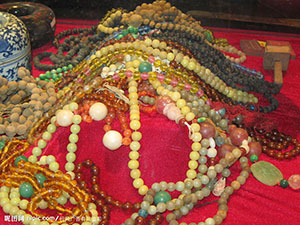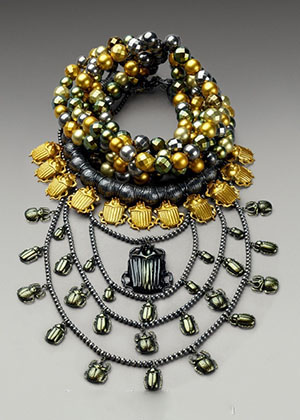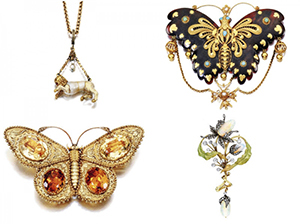The History of Jewelry
Throughout human history irrespective of religion race and culture jewelry has existed as an integral of expression, wealth and social status. While the materials and techniques used to manufacture jewelry have in many ways.

Evolving Functions of Jewelry
The function of jewelry has evolved and varied over time from a form of currency to a fashion accessory and artistic expression. Numerous cultures have utilized jewelry as a form of currency and continue to do today. Royal jewels have been used to secure the wealth of counties and many companies as the precious metal and gemstone jewelry as most expensive assets. Precious metal and gemstones have been used to create jewelry as a sign of wealth. Many forms of jewelry have their roots in function, pins, buckles and brooches were initially created to serve a specific function but later evolved into more decorative pieces eventually considered ornamentation and jewelry. Jewelry has also played an important part of religion denoting membership and status within the religion as well as various social groups.
Egyptian Jewelry
Many consider the period of Egyptian jewelry as the dawning period for our modern form of jewelry. It was during this time that the manufacturing of jewelry became a profession and techniques and skills evolved to create a wide variety of styles and adornments. Jewelry craftsman began to utilize artistic skill and wide variety of materials. While artistic skill was valued the primary purpose of jewelry was to act as amulets and talismans. Gemstone and metal color was importance than any other attribute. Gold was used extensively because it was readily available and very easy to work with. Many expensive gemstones we consider precious today like diamonds were very rarely used simply because they did not exhibit the color or symbolism of other gemstones. Egyptian beliefs stipulated that every gemstone carried certain mystical powers which would be transferred to the owner when worn as jewelry. Symbols such as the sacred Egyptian scarab also formed an important part of jewelry and were also believed to carry certain powers.

Greek and Roman Jewelry
Early Greek and Roman jewelry relied heavily upon trade with neighboring cultures and is varied in style and construction. Cultural symbolism played an important part of jewelry during this period. Greek and Roman jewelry was often created to symbolize legends and gods and later popular cultural beliefs. During this time metal working techniques evolved and jewelry pieces became more intricate and delicate. These techniques resulted in the increased popularity of earrings. Unlike other dominant cultures the Greek and Roman cultures did not ascribe to the belief that gemstones possessed certain mystical powers. For this reason stones metals are used as the predominant construction materials. This period is renowned for the creation of the cameo. The cameo is a piece of stone carved to create a portrait of a leader or god. This form of jewelry remains popular today and has enjoyed a number of resurgences throughout history. Initially Greek jewelry craftsman created highly detailed portraits of Alexander the Great. No other portraits were permitted by law until the later part of this period.

Jewelry during the Middle Age
During this period as majority people believe Christianity cultural, jewelry was used primarily as a form of symbolizing Christian faith. In the middle ages Christian monasteries were responsible for producing the better part of the worlds jewelry. Early monasteries were required to learn trades in order to support themselves financially with much jewelry craftsmanship. The first independent jewelry guilds were created to support jewelry craftsman and the industry to implementing practices quality inspections. The growing demands for jewelry and a booming population resulted in increasingly sophisticated forgeries which the guild recognized a threat to their boom trade. Celtic cultures in Ireland were not yet affected by the spread of Christianity and so a number of unique styles and manufacturing methods were developed during the time. Unlike Christian cultures of the time the Celts very rarely maintained any form of records and so little is known about the symbolism of the now wildly popular Celtic designs. Precious stones and metals were once again reserved for the wealthy and were even for lower classes during certain periods.

Jewelry during the Renaissance period
Commonly referred the “Jewel Age” began of the Renaissance period. Prior to this time jewelry considered form of symbolism and wealth, a part of expressing religious and cultural beliefs. During Renaissance period the roles of jewelry began to diverge. Increasingly jewelry served the role of body adornment, created solely for the purpose of improving personal presentation and beauty. While jewelry was already seen as sign of wealth and now began to collect it to protecting ones wealth. As a form of currency it was easily protected, easy to sell and universally valuable. Due to the focus on the role of jewelry in enhancing beauty gemstones were prized for attributes such as color, luster and shine over the previously held beliefs of mystical powers. For the first time in history the use of Diamond was popularized and a number of cutting methods and shapes were developed. Discoveries of new countries resulted in massive influx of previously scarce metals and gemstones. The majority of extravagant pieces we recognize today were commission by French and English royalty during this period.
17th Century Onwards
The increasing wealth of the general population and relatively relaxed social attitudes meant that the gold and silver pieces usually reserved for the rich and powerful could now be afforded by lower classes. The popularity of diamonds continued and so too did the methods of cutting diamond. Large scale war destroyed many of the precious glass from the ‘Jewel Age’ and earlier. During this time the discovery of new countries and the spread of affordable media resulted in a fascination of previously unimagined flora and fauna. Jewelry began to take on the shapes of floral designs and animals with vividly colored gemstones and metals. This trend continued until the early part of the 20th Century and evolved with manufacturing technique to include intricate glass creations. The industrial revolution introduced unprecedented change to the world and jewelry fashions and trends changed faster than ever. Jewelry crafted during the Art Nouveau, Edwardian, Art Deco and Retro periods in particular are still popular today.

Present day and future
Today jewelry is increasingly viewed as a form of artistic expression as the tools and materials of production become increasingly affordable and available. This trend also continues to grow due to the fact that precious metals and gemstones are no longer utilized as signs of wealth and social status. Dramatic improvements in technology mean that jewelry constructed from affordable and readily available resources as well as synthetic materials are capable of rivaling the beauty of the most expensive natural gemstones and metals. These factors have contributed to a focus on design, creativity and artistic expression over symbolism and social status. As social barriers are removed and cultural influences are shared the variety of styles available increases. The predominant style of spring may vary completely from the predominant style of autumn. In addition to the increasing rate of change jewelry is now accepted more as a form of personal expression and so a wider and wider variety of styles continue to grow.


Comment (0)